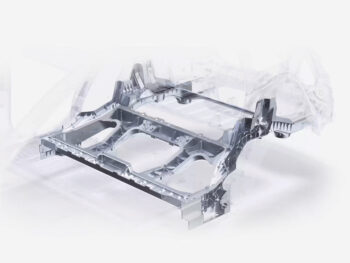Breaking the mould: The rise of gigacasting and the implications for fleets
As manufacturers chase cost out of increasingly technology rich new models, our editor-at-large wonders how ‘gigacasting’ might affect the repair process.

Gigacasting (or ‘megacasting’) is already in use with best-selling models in the UK
Already scrambling to keep up with emerging regulations and technology, fleet decision-makers could be excused for not paying much attention to the workings of the modern car factory. However, changes here can be disruptive – innovations on the production line promise safer, cheaper, more efficient vehicles, which is good – but the growing momentum behind ‘gigacasting’ might raise an eyebrow.
With a name like that, it’s no surprise to hear Tesla is spearheading this technology. Gigacasting (or ‘megacasting’) replaces structural sections, traditionally assembled from multiple pressed steel components, with a single piece of die-cast aluminium alloy. The goal is cheaper, simpler production and it’s already in use. The Model Y features a gigacast section – and that’s the UK’s fifth best-selling car, with a sizeable fleet uptake.
Tesla isn’t alone. Volvo claims megacasting will reduce the weight, extend the range and cut the cost and environmental impact of building its future EVs. Chinese brand Nio is already using it, Volkswagen Group and Toyota have hinted they will, while Reuters has reported that Hyundai and Ford are researching it too.
However, that enthusiasm isn’t universal. Consultancy firm Ducker recently issued a white paper questioning the claimed weight advantages and raising concerns about repairability. Replacing entire die-cast sections instead of individual parts could, it said, make vehicles more likely to become uneconomical to repair after a collision.
This approach would continue an existing trend. Stricter crash tests and the resulting influx of technology and exotic materials are already inflating the cost of repairs. The Association of British Insurers says costs have increased by 33% this year alone, including a 12-21% rise in parts prices and more expensive bodyshop and labour rates. Scrapping more cars feels like a fair trade-off to improve safety, but making resource-heavy EVs more disposable to slash list prices is a difficult line to tread.
Those concerns have been relayed to Thatcham Research, which assesses vehicle safety, security and sustainability, sets insurance group ratings and helps manufacturers design ease of repair into new models. Darren Bright, principal engineer – automotive repair, says repairability is an important consideration. Expensive claims can mean pricier premiums and uncompetitive operating costs, so gigacasting is under the spotlight.
Research so far has focused on the rear structure of the Model Y, as UK right-hand drive models don’t have the gigacast front-end used in other markets. This single part includes the rear chassis legs, wheel wells and part of the boot floor, so it’s vulnerable in rear or side impacts, but it can be repaired. Tesla sells repair sections for at-risk areas, such as behind the bumper and inside the door jambs, and only advises a full replacement if the damage affects specific structural sections.
However, Bright adds, the repair process is novel and comparisons are difficult. The high-strength steels used to protect occupants (and HV components) in modern cars often can’t be welded as the heat affects their strength. If these are not designed with repairs in mind (such as including joins on chassis legs) then rebuilding large steel structure from individual parts can be laborious and prone to supply disruption. Both of those factors can increase the likelihood of repairs becoming uneconomical. Courtesy cars are expensive.
Bright says research is ongoing: “We want to look at what’s involved with fitting the whole gigacast section – and what severity of damage would require a replacement. A potential scenario is you hit the rear wheel, snap the suspension and the shock goes into some of the webbing. Potentially, then, you’re into a full replacement for minor damage – and that’s the sort of thing we’re looking to conclude in future.”
Time will tell. There’s more to learn about repair costs, but gigacasting promises cheaper production while removing many of the stress and rust-prone connections that eventually cause steel-bodied vehicles to become unroadworthy. It’s something decision-makers should be watching closely.












